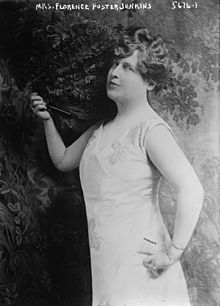1868 - 1944
By: Donald Tang | Date Added:

Florence Foster Jenkins born Narcissa Florence Foster; July 19, 1868 – November 26, 1944 was an American socialite and amateur soprano who was known, and mocked, for her flamboyant performance costumes and notably poor singing ability. Stephen Pile ranked her "the world's worst opera singer ... No one, before or since, has succeeded in liberating themselves quite so completely from the shackles of musical notation." Because of her technical incompetence, she became a prominent musical cult figure in New York City during the 1920s, 1930s, and 1940s. Cole Porter, Gian Carlo Menotti, Lily Pons, Sir Thomas Beecham, and other celebrities were fans. Enrico Caruso is said to have "regarded her with affection and respect". The poet William Meredith wrote that a Jenkins recital "was never exactly an aesthetic experience, or only to the degree that an early Christian among the lions provided aesthetic experience; it was chiefly immolator, and Madame Jenkins was always eaten, in the end." Narcissa Florence Foster is the daughter of Charles Dorrance Foster (1836–1909), an attorney and scion of a wealthy land-owning Pennsylvania family, and Mary Jane Hoagland Foster (1851–1930). Her one sibling, a younger sister named Lillian, died at the age of eight in 1883 of diphtheria. Foster said her lifelong passion for public performance began when she was seven years old. A talented pianist, she performed at society functions as "Little Miss Foster” and gave a recital at the White House during the administration of President Rutherford B. Hayes. After graduating from high school, her hopes of studying music in Europe were dashed when her father refused permission, and funding. In 1885, at the age of 17, Florence eloped with Frank Thornton Jenkins, a physician 16 years her senior, to Philadelphia, where they married. The following year, after learning that she had contracted syphilis from her husband, she ended their relationship and reportedly never spoke of him again. Years later, she claimed to have been granted a divorce decree on March 24, 1902, although no documentation of any such ruling has been found. She retained the Jenkins surname for the remainder of her life. After an arm injury ended her aspirations as a pianist, Jenkins gave piano lessons in Philadelphia to support herself; but around 1900 she moved with her mother to New York City. In 1909, in her early forties, Jenkins met a 33-year-old British actor named St. Clair Bayfield; they began a vaguely defined cohabitation relationship that continued the rest of her life. Upon her father's death later that year, Jenkins became the beneficiary of a sizable trust, and resolved to resume her musical career as a singer, with Bayfield as her manager. She began taking voice lessons and immersed herself in wealthy New York City society, joining dozens of social clubs. As the "chairman of music" for many of these organizations, she began producing lavish tableaux vivants popular diversions in upper-crust social circles of that era. In each of these productions, Jenkins would invariably cast herself as the main character in the final tableau, wearing an elaborate costume of her own design. In a widely republished photograph, Jenkins poses in a costume, complete with angelic wings, from her tableau inspired by Howard Chandler Christy's painting Stephen Foster and the Angel of Inspiration. Jenkins began giving private vocal recitals in 1912 when she was 44 years old. In 1917, she became founder and "President Soprano Hostess" of her own social organization, the Verdi Club, dedicated to "fostering a love and patronage of Grand Opera in English". Its membership quickly swelled to over 400; honorary members included Enrico Caruso and Geraldine Farrar. When Jenkins's mother died in 1930, additional financial resources became available for the expansion and promotion of her singing career.
click hereShare your thoughts on this story with us. Your comments will not be made public.
Email
Copyright ©2016 - Design By Bureau Blank